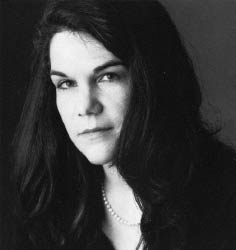Next story: Team of Rivals: The Political Genius of Abraham Lincoln, by Doris Kearns Goodwin
Dawn Raffel
by Forrest Roth

Dawn Raffel is the featured visiting writer for the final COMMUNIQUE: Flash Fiction reading of the season, which takes place this Friday at Big Orbit Gallery (30D Essex St.) at 7pm, with Erin Gay from Syracuse opening. Raffel is the author of a story collection, In the Year of Long Division (Knopf 1994), and a novel, Carrying the Body (Scribner 2002). Artvoice recently had the opportunity to conduct an email interview to ask her about these two books:
The secluded environments in In the Year of Long Division have an intense, expressive quality associated with autobiography. How much did your earliest surroundings, your childhood in Wisconsin, affect the work in that collection? “Almost everything I write is set in Wisconsin. I haven’t lived there since I was 17, so I suspect it’s a deeply mythologized Wisconsin.”
In “Seeds in Public Places,” a mother wonders rhetorically to her soon-to-be engaged daughter, “If things we owned could talk,” while educating her about fine crystal. Could you explain this fascination with material possessions reflecting personal substance that appears often in your stories? “I tend to stay on the surface in order to let the reader make his or her own interpretation. I do think the objects with which we surround ourselves, the things that pass through our hands, can speak volumes about the inner life—whereas I find psychological labels reductive and tired.”
The relationships between your characters—filial or otherwise—seem to be enveloped by emotional vacuums they themselves create, struggle in and out of. Is true intimacy that difficult for them to find on the page? “I think it’s that difficult to find in real families. Both the collection and the novel are concerned with the imperfection of love—with the longing for perfect connection and the impossibility of that ideal. Very often in the dialogue, you’ll see that one character isn’t quite answering the other. As a journalism student, I logged in many hours writing down verbatim how people actually talk—how disjointed our conversations can be, how often we don’t hear what the other person just said because we have an agenda; our personal drama is ringing in our ears.”
What was the impetus behind Carrying the Body? Did you conceive it as a novel when you started, or did it begin as a series of intertwined short fictions? Did the end result meet your expectations? “I wrote the first chapter as a short story. It was published but I didn’t feel satisfied that it was complete. I decided to write a novel about these characters and their situation and spent the better part of a year trying to find a way in—a means to construct this as a novel. I had all kinds of ideas about structure that died on the table because they were overly schematic. Finally, the obvious—why not just start with the story, go from there and see what happens?—occurred to me. In some way, it felt like the jumping-off-a-cliff method of writing a novel. The challenge I set for myself was to see whether I could go into a very dark place and come out plausibly on the side of light. Yes, I think I got there, but as you know, the novel on the page is never as wonderful as the novel in your head.”
Carrying the Body has a humorous take on the “Three Little Pigs” tale (Aunt’s exasperating attempts to tell it to the boy), which is subtly incorporated into the novel’s storyline. What was your intent in developing this tale as a leitmotif? “I love fairytales—they carry such deep psychological truths and they are so malleable. Both of my children loved ‘The Three Little Pigs’ and begged for it again and again. I discovered that there are many, many versions of this tale, with varying degrees of violence. I also believe that we reveal ourselves whenever we tell a story, whether it’s ours or one that belongs to everyone. The more Aunt tries to recall ‘The Three Little Pigs,’ the more it becomes corrupted by her inner life.”
|
Issue Navigation> Issue Index > v5n17: Power Failure (4/27/06) > Dawn Raffel This Week's Issue • Artvoice Daily • Artvoice TV • Events Calendar • Classifieds |









 Current Issue
Current Issue